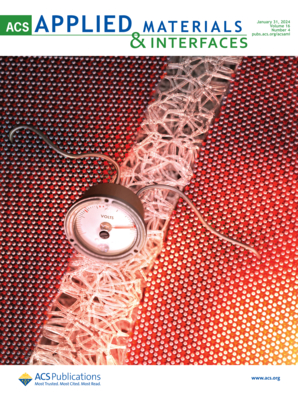Ultrafine Mo2N Quantum Dots Embedded in N-Doped Graphene Sheets Enable Efficient Adsorption-Catalytic Transformation of Polysulfides
IF 8.3
2区 材料科学
Q1 MATERIALS SCIENCE, MULTIDISCIPLINARY
引用次数: 0
Abstract
Because of the high theoretical energy density of 2600 Wh kg–1, lithium–sulfur batteries (LSBs) are anticipated to be among the next generation of high-energy-density storage technologies. However, the practical application of LSBs has been severely hampered by the significant shuttle effect and slow redox kinetics of polysulfides (LiPSs). To address the above problems, in this paper, the concept of quantum dots (QDs) was introduced to design and synthesize Mo2N QD-modified N-doped graphene nanosheets (marked as Mo2N-QDs@NG), which were used as separator modification materials for LSBs. The experimental results demonstrated that the introduction of Mo2N QDs avoids stacking of graphene sheets and provides more active sites for the conversion of LiPSs. Moreover, Mo2N enhances the chemical fixation and catalyzes the liquid–solid conversion of soluble LiPSs by forming Mo–S and Li–N bonds with LiPSs. Additionally, establishing Mo–C bonds with Mo2N, N-doped graphene sheets can facilitate the transport of electrons and ions and physically prevent the diffusion of LiPSs, thus creating a highly conducting carbon structure to support electrochemical reactions. Benefiting from the synergistic effect of chemical immobilization and catalysis of Mo2N QDs with the physical confinement of NG, Mo2N-QDs@NG-PP batteries exhibit enhanced electrochemical performance.

嵌入 N 掺杂石墨烯片的超细 Mo2N 量子点可实现多硫化物的高效吸附-催化转化
锂硫电池(LSB)的理论能量密度高达 2600 Wh kg-1,因此有望成为下一代高能量密度存储技术。然而,多硫化物(LiPSs)明显的穿梭效应和缓慢的氧化还原动力学严重阻碍了 LSBs 的实际应用。针对上述问题,本文引入量子点(QDs)的概念,设计并合成了 Mo2N QDs 修饰的 N 掺杂石墨烯纳米片(标记为 Mo2N-QDs@NG),并将其作为 LSBs 的分离修饰材料。实验结果表明,Mo2N QDs 的引入避免了石墨烯片的堆叠,为锂离子电池的转化提供了更多的活性位点。此外,Mo2N 通过与 LiPSs 形成 Mo-S 和 Li-N 键,增强了化学固定性并催化了可溶性 LiPSs 的液固转化。此外,通过与 Mo2N 形成 Mo-C 键,掺杂 N 的石墨烯薄片可以促进电子和离子的传输,并从物理上阻止 LiPSs 的扩散,从而形成一个支持电化学反应的高导电性碳结构。得益于 Mo2N QDs 的化学固定和催化与 NG 的物理限制的协同效应,Mo2N-QDs@NG-PP 电池表现出更高的电化学性能。
本文章由计算机程序翻译,如有差异,请以英文原文为准。
求助全文
约1分钟内获得全文
求助全文
来源期刊

ACS Applied Materials & Interfaces
工程技术-材料科学:综合
CiteScore
16.00
自引率
6.30%
发文量
4978
审稿时长
1.8 months
期刊介绍:
ACS Applied Materials & Interfaces is a leading interdisciplinary journal that brings together chemists, engineers, physicists, and biologists to explore the development and utilization of newly-discovered materials and interfacial processes for specific applications. Our journal has experienced remarkable growth since its establishment in 2009, both in terms of the number of articles published and the impact of the research showcased. We are proud to foster a truly global community, with the majority of published articles originating from outside the United States, reflecting the rapid growth of applied research worldwide.
 求助内容:
求助内容: 应助结果提醒方式:
应助结果提醒方式:


